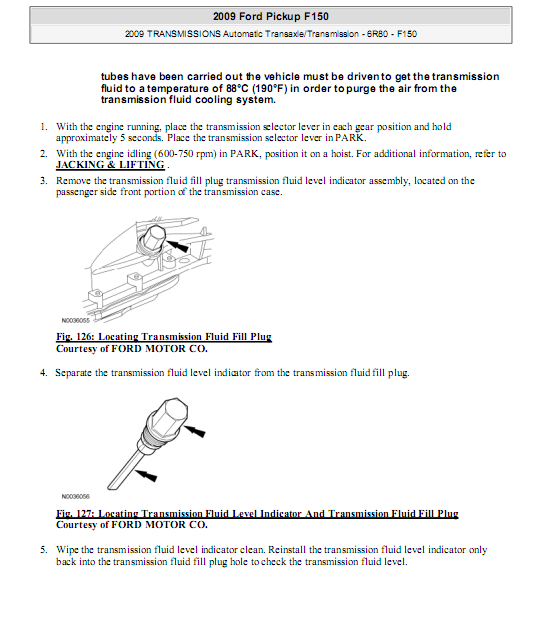How To Check Transmission Fluid Ford F150
Last Updated on by David Jon
In this comprehensive guide, we aim to alleviate some of the anxieties facing Ford F150 owners and enthusiastic DIYers, by offering step-by-step instructions on how to check the transmission fluid of your Ford F150. As an essential aspect of vehicle maintenance, conducting regular checks and timely interventions can greatly improve the lifespan and performance of your vehicle. From mechanics to Ford fanatics, everyone stands to benefit from our detailed procedures and professional tips. We promise to make it as straightforward as possible, ensuring you have the knowledge to confidently carry out this vital task.

Understanding the Importance of Transmission Fluid
Transmission fluid is of paramount importance in the overall performance of your Ford F150 vehicle. This critical fluid serves several crucial roles that directly impact the performance, efficiency, and longevity of your automobile.
Role of transmission fluid in vehicle performance
Transmission fluid primarily acts as the lubricant for various components in your vehicle’s transmission system. Its function is to ensure the smooth operation of the gears and prevent overheating caused by friction. Moreover, the fluid also acts as a coolant, reduces wear and tear on moving parts, and improves the transmission’s overall efficiency.
Possible problems due to lack of sufficient transmission fluid
Inadequate transmission fluid can lead to a host of issues. From causing the transmission to overheat to additional wear on moving parts due to insufficient lubrication, lack of transmission fluid can result in premature transmission failure. Delayed gear shifting, a noise from the transmission, and slipping gears are signs that you may have insufficient transmission fluid in your vehicle.
Importance of regular checks of transmission fluid
Regularly checking the transmission fluid levels ensures that your vehicle’s performance remains optimal and efficient. Ignoring this essential maintenance task can lead to significant and costly repair bills in the future. It’s crucial for us to routinely check not just the levels but also the quality and condition of the transmission fluid.
Identifying the Locality of the Transmission Fluid Dipstick
Checking your vehicle’s transmission fluid is pretty straightforward, but the first step is to locate the transmission fluid dipstick.
Locating the hood release
The hood release is usually found on the driver’s side below the steering column. Once you’ve located the hood release, pull it to open the hood.
Identifying the transmission fluid dipstick under the hood
After you open the hood, locate the transmission fluid dipstick. It may vary based on the model of your Ford F150 but generally, it’s located towards the back of the engine compartment near the firewall.
Differentiating between engine oil and transmission fluid dipstick
Ensure not to confuse the transmission fluid dipstick with the engine oil dipstick. They have differentiating characteristics. Typically, the transmission fluid dipstick’s handle is marked with “Trans” or a similar indicator, and it’s usually further back than the oil dipstick.

Preparations before Checking Transmission Fluid Level
Before you begin checking the transmission fluid level, it’s crucial to take some preparatory measures.
Safety measures while dealing with the engine parts
Safety should always be our priority. Always ensure your Ford F150 is parked on a level area, and the engine is switched off. Use gloves and safety glasses to protect yourself from any dirt particles or hot engine components.
Ideal engine and ambient temperature for fluid level check
The engine needs to be warm, but not hot. It’s best to check the transmission fluid level after your vehicle has been driven for approximately 20 minutes.
Proper positioning of the Ford F150 for accurate reading
Park your vehicle on a flat surface to ensure an accurate reading. Be sure to set the parking brake to prevent it from moving.
Procedure to Check Transmission Fluid Level in Ford F150
Once the preparations are complete, you can then proceed to check your Ford F150’s transmission fluid level.
How to pull out the dipstick
Gently withdraw the dipstick from the tube and wipe it clean with a lint-free rag or paper towel.
Reading the transmission fluid level accurately
Reinsert the dipstick fully into the tube, then withdraw it again. Observe the fluid level on the dipstick, it should be in the ‘HOT’ area if the engine was in operation and is still warm.
Understanding the markings on the dipstick
In general, there are two markings: one for ‘HOT’ (the engine is at normal operating temperature) and one for ‘COLD’ (the engine is cool). The fluid should be within these two markings.

Interpreting the Color and Smell of Transmission Fluid
While checking the transmission fluid level, it’s just as important to inspect the quality of the fluid.
Ideal color of healthy transmission fluid
Fresh transmission fluid tends to be a clear, bright red color. If your vehicle’s transmission fluid continues to have a crisp red color, it’s in excellent condition.
Change in color and what it indicates
Over time, the color of the fluid may darken due to contaminants and oxidation. If it becomes a dark red, brown, or appears to have particles, it indicates that the fluid may need changing.
Smell of the transmission fluid and possible issues
Transmission fluid tends to have a somewhat sweet or tart smell. If it has a burnt odor, it may indicate severe transmission issues.
Steps for Topping Up Transmission Fluid in Ford F150
Selecting the right type of transmission fluid for Ford F150
Typically, your Ford F150 will require a specific type of transmission fluid. Always refer to the owner’s manual for the recommended fluid type.
Procedure for adding fluid to the transmission system
To add fluid, you will need a funnel. Insert the funnel into the hole where you removed the dipstick and pour the fluid. Be careful not to overfill it, as this could damage your transmission.
Checking levels after adding the fluid
After adding the fluid, reinsert the dipstick, give it a few minutes for the fluid to settle down, draw it out again and check the level. Repeat the process until the level reaches the ‘HOT’ marking on the dipstick.

Understanding When to Change Transmission Fluid
Recommended transmission fluid change intervals for Ford F150
For Ford F150, the manufacturer typically recommends changing the transmission fluid every 60,000 to 100,000 miles. However, consult the owner’s manual for specific recommendations.
Signs that indicate a need for fluid change
Indicators for changing transmission fluid include dirty or discolored fluid, burnt smell, and problems with gear shifting. Regularly replacing the fluid will ensure optimal performance.
Potential consequences of not changing fluid regularly
If the fluid isn’t changed regularly, it could lead to transmission problems, loss of acceleration, or even transmission failure in severe cases.
Tips for Maintaining Transmission Fluid Levels
Proper maintenance of transmission fluid is crucial for a healthy vehicle.
Routine checks for transmission fluid
Having a regular transmission fluid check schedule will help trace issues before they escalate into costly repairs. A monthly check is generally recommended.
Prevention of possible transmission fluid leaks
Regularly check under your vehicle for any signs of a transmission fluid leak. If you spot a leak, it’s important to identify the source and fix it as soon as possible.
Hot climate and its effect on transmission fluid
Heat can break down the transmission fluid, making it less effective. Pay more attention to your transmission fluid if you live in a hot climate or frequently haul heavy loads.

Commonly Asked Questions About Transmission Fluid Check
We often get queries from Ford owners, DIY enthusiasts, and even mechanics about transmission fluid checks. Here, we answer a few frequently asked questions.
Queries about transmission fluid levels
“How to know if the transmission fluid level is low?” Usually, a dipstick reading below the ‘COLD’ mark indicates low fluid levels. Also, difficulty in shifting gears or a slipping transmission could be signs of low transmission fluid.
Frequently asked questions about changing transmission fluid
“How frequently should I change the fluid?” Ideally, for Ford F150, we recommend changing it every 60,000 to 100,000 miles.
Concerns about leakage and possible fixes
“Is a leak of transmission fluid a serious issue?” Absolutely, a leak can lead to low fluid levels, impacting the transmission’s performance and potentially leading to damage.
Knowing the Automatic Transmission Fluid (ATF) Specifications for Ford F150
Ensuring you use the correct transmission fluid in your Ford F150 is integral to its performance and longevity.
Reading the Ford F150 manual for ATF specifications
The vehicle owner’s manual will provide the specifications for the correct type of ATF that is suitable for your particular Ford F150 model.
Understanding the different types of ATFs
There are different types of ATFs available in the market, such as synthetic, multi-vehicle, high-mileage, and standard ATF. Ensure you know the right type for your vehicle to avoid potential damage.
Choosing the right ATF
Select the ATF based on your Ford F150’s specifications. Incorporating the wrong ATF could result in damage to the transmission, which can be costly to repair.
In conclusion, understanding and effectively managing your Ford F150’s transmission fluid is pivotal for the vehicle’s optimal performance and longevity. Regular checks, maintenance, and fluid change will keep your ride smooth and efficient, keeping you safe on the road.


